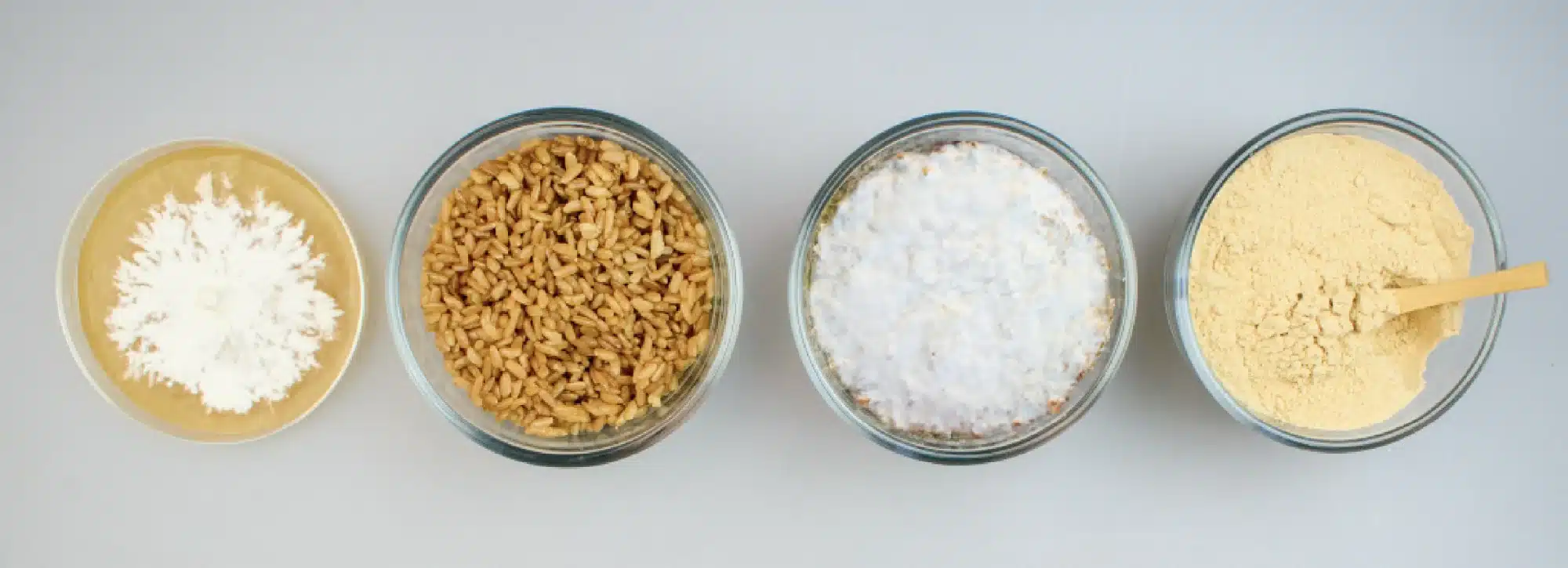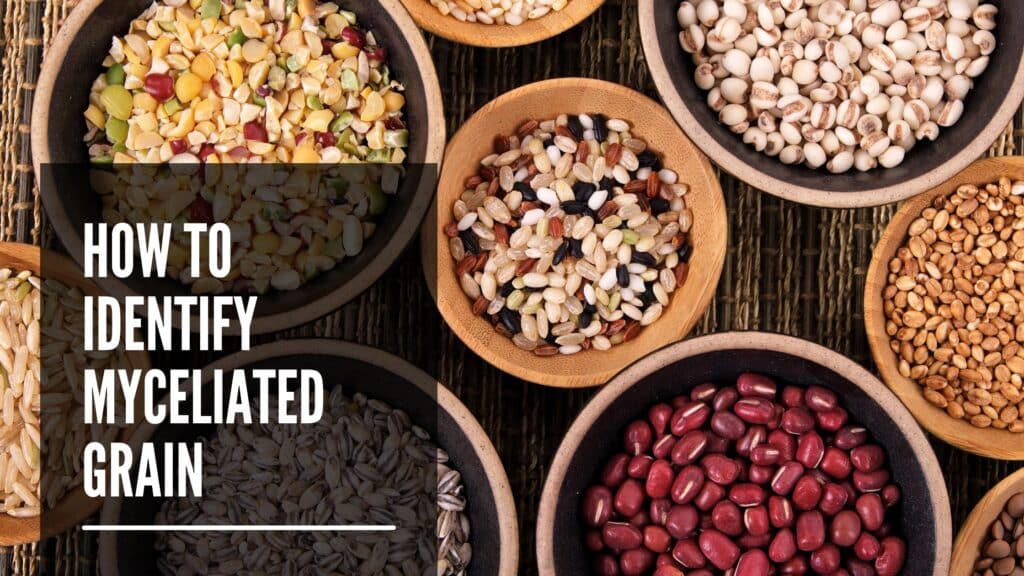Identifying myceliated grain is an essential skill for anyone interested in mushroom cultivation, whether you’re a hobbyist or a commercial producer. Getting this step right is key to ensuring healthy growth and high-quality mushrooms. Myceliated grain serves as the foundation for successful cultivation, providing a nutrient-rich environment where fungi can thrive. Proper identification helps prevent contamination, ensures the best possible outcomes, and ultimately leads to a more rewarding and fruitful growing experience.
Quick Summary
- Definition: Myceliated grain and its role in fungal life cycles.
- Differences: Distinguishing myceliated grain from mushroom fruiting bodies.
- Characteristics: Key features including color, texture, smell, and growth patterns.
- Visual Identification: Tips for identifying healthy mycelium and contamination.
What is Myceliated Grain?

Definition
Myceliated grain is a term used to describe grains that have been colonized by mycelium, the vegetative part of a fungus. Picture it as the network of white, thread-like structures that spread through the substrate, much like the roots of a plant. These grains, commonly rye, wheat, or millet, act as a nutrient-rich medium, providing the mycelium with the food it needs to grow and eventually produce mushrooms.
In the life cycle of fungi, mycelium is the stage where the fungus builds up its strength and spreads through its environment. It’s essentially the working part of the fungus, breaking down organic matter to absorb nutrients. When you see myceliated grain, you’re looking at a crucial phase where the fungus is preparing itself for the next stage—producing fruiting bodies, which are the mushrooms we typically recognize.
Usage
Myceliated grain is a cornerstone in mushroom cultivation, widely favored for its efficiency and effectiveness. Here’s why it’s so popular:
- Inoculation Medium: These grains are used to inoculate bulk substrates. The mycelium colonizes the grains first and then spreads into larger substrates like sawdust or straw, accelerating the growth process.
- Nutrient-Rich: Grains provide a rich nutrient base that supports vigorous mycelial growth. This ensures that when the fungus transitions to fruiting, it has ample energy and resources to produce healthy, robust mushrooms.
- Ease of Use: For both beginners and experienced cultivators, myceliated grain is relatively easy to work with. It can be mixed into substrates without needing specialized equipment, making it accessible for small-scale home growers and large-scale commercial operations alike.
- Consistency: Using myceliated grain helps maintain consistency in mushroom production. By starting with a controlled, colonized medium, growers can reduce the variability that might arise from starting directly with less predictable substrates.
In essence, myceliated grain serves as the bridge between spore or liquid culture and the final mushroom harvest. It’s the stage where the fungus consolidates its growth, ensuring that when it’s time to fruit, the process is smooth and productive.
The Difference Between Myceliated Grain and Mushroom Fruiting Bodies

Appearance
When it comes to distinguishing myceliated grain from mushroom fruiting bodies, the visual differences are quite striking. Myceliated grain looks like regular grains enveloped in a white, fuzzy, or sometimes cotton-like growth. This white covering is the mycelium, which spreads out in a network of fine threads, creating a somewhat uniform appearance across the grains.
In contrast, mushroom fruiting bodies are what most people think of when they hear the word “mushroom.” These are the fully formed mushrooms, featuring distinct parts such as caps, stems, and gills. The caps can vary widely in shape, size, and color, depending on the species, but they are usually more robust and visible compared to the fine, delicate appearance of mycelium.
Composition
The compositional differences between myceliated grain and mushroom fruiting bodies are equally important. Myceliated grain consists of two primary components: the grains themselves (rye, wheat, or millet) and the mycelium that colonizes them. The grains serve as a nutrient base, providing the necessary food for the mycelium to grow and thrive.
On the other hand, mushroom fruiting bodies are composed of various tissues that form the cap, gills, and stem. These tissues are more complex than mycelium and have specific functions related to the reproduction of the fungus. For instance, the gills or pores underneath the cap are where spores are produced and released, allowing the fungus to propagate.
Understanding these compositional differences is crucial because it influences how each is used. Myceliated grain is primarily used as an inoculant, a starter medium that is introduced to larger substrates to promote further fungal growth. Mushroom fruiting bodies, however, are harvested for their culinary and medicinal properties.
Key Characteristics of Myceliated Grain
Color
The color of myceliated grain is a primary indicator of its health and viability. Healthy myceliated grain is typically white, which signifies that the mycelium is thriving and actively colonizing the grains. This whiteness should be uniform across the grains, creating a consistent appearance.
However, the color can also signal problems. For example, green or black patches often indicate mold contamination, which can outcompete and harm the mycelium. Yellow or pink hues can suggest bacterial contamination, which not only disrupts the growth of the mycelium but can also pose health risks. Recognizing these color changes early can save a batch from complete ruin.
Texture
Texture provides additional clues about the condition of myceliated grain. Healthy myceliated grain has a firm yet slightly spongy texture, thanks to the dense network of mycelial threads weaving through the grains. As the mycelium colonizes the grains, it binds them together, giving the substrate a cohesive feel.
During colonization, the texture may change subtly. Initially, grains may feel loose and separate, but as the mycelium grows, it creates a more solid mass. If the grains feel overly dry, it might indicate insufficient moisture, which can hinder mycelial growth. Conversely, if they feel slimy or overly wet, this could point to bacterial contamination, which often accompanies excess moisture.
Smell
The smell of myceliated grain is another critical characteristic to monitor. Healthy mycelium emits a fresh, earthy aroma, reminiscent of a forest after rain. This smell indicates a thriving fungal culture and proper environmental conditions.
Any deviation from this pleasant smell should be a red flag. Sour, sweet, or musty odors often signify contamination. For instance, a sour smell might suggest bacterial growth, while a musty odor could indicate mold. Promptly identifying and addressing these smells can prevent the spread of contaminants and preserve the integrity of the myceliated grain.
Growth Patterns
Observing the growth patterns of mycelium can provide insights into the health and species-specific characteristics of the fungus. Mycelium typically radiates outward from the inoculation point, spreading uniformly if the conditions are optimal. The growth should be even, covering the grains without leaving significant gaps or showing uneven colonization.
Different mushroom species can exhibit unique growth patterns. For example, some may grow more rapidly or densely than others. Understanding these patterns helps in adjusting cultivation techniques to suit the specific needs of the mushroom being grown.
Healthy Mycelium
Identifying healthy mycelium is crucial for successful mushroom cultivation. Healthy mycelium is an indicator that the fungal culture is thriving and ready to transition to the next stages of growth. Recognizing the signs of healthy mycelium ensures that the cultivation process is on the right track and helps in early detection of any issues that might arise.
Contamination Signs
Recognizing signs of contamination in myceliated grain is essential to ensure the health and success of your mushroom cultivation. Contaminants can outcompete the mycelium, potentially ruining an entire batch and posing health risks. Understanding what to look for can help in early detection and prompt action to mitigate these issues.
Discoloration
One of the most obvious signs of contamination is discoloration. Healthy mycelium is typically bright white, while contaminants often appear in various other colors:
-
Green: Green patches usually indicate mold, particularly species like Trichoderma. This mold is a common contaminant in mushroom cultivation and can spread rapidly if not addressed.
-
Black: Black spots can suggest the presence of mold spores or other fungal contaminants. This is often a sign of advanced contamination.
-
Pink or Red: These colors often point to bacterial contamination. Bacteria can thrive in overly moist conditions and can quickly turn a healthy substrate into a breeding ground for pathogens.
-
Yellow: Yellowing can be a sign of bacterial presence or stress in the mycelium due to suboptimal conditions, such as too much moisture or poor air circulation.
Texture Changes
Changes in texture are another indicator of contamination. Healthy mycelium is firm and slightly spongy, but contaminants can alter this texture:
-
Slimy: A slimy texture often suggests bacterial contamination. This slime can make the grain clump together in an unnatural way and can emit a foul odor.
-
Crusty or Powdery: A crusty or powdery texture can indicate mold growth. These textures suggest that the contaminant is drying out the substrate or spreading spores.
-
Soft and Mushy: Overly soft or mushy grains may be a sign of rot, often due to bacterial infection. This can lead to a breakdown of the grain’s structure, making it unusable.
Unpleasant Odors
The smell of your myceliated grain can provide significant clues about its health. While healthy mycelium emits a fresh, earthy scent, contaminants often produce distinctly unpleasant odors:
-
Sour: A sour smell typically indicates bacterial contamination. This smell can be quite pungent and unpleasant, signaling the need for immediate attention.
-
Musty or Moldy: Musty odors are often associated with mold growth. This smell is similar to that of a damp basement and indicates that mold spores are present and proliferating.
-
Sweet: A sweet smell can also be a sign of bacterial contamination, particularly if it’s accompanied by other signs like sliminess or discoloration.
Conclusion
Properly identifying myceliated grain is crucial for anyone involved in mushroom cultivation. By recognizing the signs of healthy mycelium and understanding the indicators of contamination, you can ensure the success of your growing efforts.
Healthy mycelium should be bright white, firm, and have a fresh, earthy smell. Be vigilant for signs of contamination, such as discoloration, unusual textures, and unpleasant odors. By following these guidelines, you can maintain the integrity of your myceliated grain and achieve better results in your mushroom cultivation.
Paying attention to these details not only enhances the quality of your mushrooms but also ensures a safer and more productive growing environment. Whether you’re an amateur mycologist or a commercial producer, these tips will help you keep your mycelium in top condition and support a thriving mushroom cultivation process.

